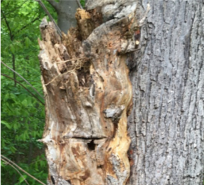Trees are a magnificent presence in our world. Since childhood, I’ve known trees as friends and trusted confidants. Whether walking under a thick forest canopy or sitting underneath a lone cottonwood somewhere in New Mexico, the strength and feeling of peace are tangible. Older trees often express their personality in bark faces. I’m one of many taking and posting Instagram photographs of expressions formed from jagged, rough, bark edges. Some bark faces are light and humorous; others can be dark and powerful. We bring to the image what we see, but in doing so, there is a tangible connection with the tree. We know different trees have different bark patterns, but why?
Think of tree bark as the protective layer between the tree and the environment. Bark insulates against extremes in temperature and protects a tree from insects and parasites. A tree trunk has multiple layers, the outermost being bark. In-between bark and wood, there is a thin layer of tissue where cells grow and divide. This growth adds a ring of wood to the inside of the tree, and new bark to the outside. Some trees have bark that adapts and “stretches” with the pressure of growth, while others have bark that breaks and cracks. A beech tree’s smooth bark adapts, while an old oak or cottonwood forms deep bark patterns.
As artists, we observe, but also profoundly feel our world. The next time you pass a tree in your wanderings, especially an older tree, close your eyes and place the palms of your hands on the bark. Follow the pattern of ridges or feel the smoothness. Take in the strength and peace, understanding that the tree may be as aware of you as you are of the tree. And as you wander, look for faces and expressions in tree bark patterns. There’s humor there and somehow, great wisdom.
Photo credit: Dee Stribling Creative
Supporting articles:
The Secret Life of Trees: The Astonishing Science of What Trees Feel and How They Communicate
